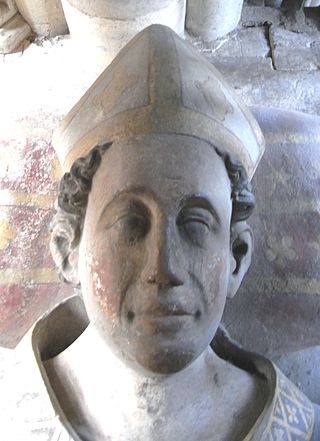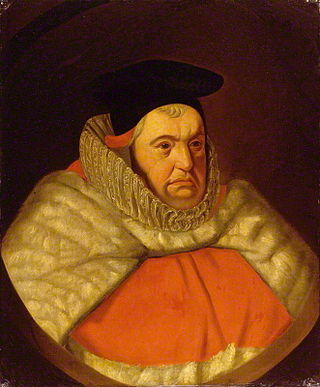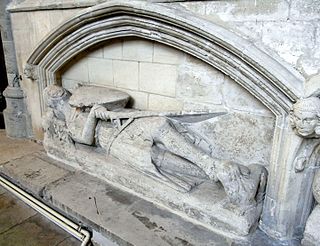


Sir Richard Stapledon (died 1326) was an English judge and politician, the elder brother of Walter Stapledon (died 1326), Bishop of Exeter. His effigy and monument survive in Exeter Cathedral.



Sir Richard Stapledon (died 1326) was an English judge and politician, the elder brother of Walter Stapledon (died 1326), Bishop of Exeter. His effigy and monument survive in Exeter Cathedral.
The Stapledons were minor gentry who had lands at Stapledon in the parish of Cookbury in Devon, his parents being William and Mabel Stapledon and his younger brother Walter Stapledon. [2]
Stapledon was a lawyer and a judge, a Justice of Assizes for the western circuit. [3] Few records have survived concerning his career. In August 1315 he entertained his brother the bishop at his manor house at Stapledon when he came to dedicate Cookbury church. He also was granted by his brother a licence to have a private chapel at Stapledon, a common request made by many of the medieval country gentry. The estate of Stapledon descended as Annery. [4]
Records of a lawsuit brought against "Richard de Stapledon, knight, of Devon" in 1341/5, thus after his death, or perhaps referring to a son then living, for recovery of a debt of £28 5 shillings owed to Master Robert Hereward, Archdeacon of Taunton, reveal that Stapledon held lands in Devon including one knight's fee in Huish, Fremington Hundred; parts of a fee in Stapledon, Cookbury, etc. in Black Torrington Hundred; in West Down, Braunton Hundred and in Broad Harford in South Molton Hundred. [5]
Stapledon was granted the demesnes of the manor of Milton Damerel by Hugh Courtenay, 2nd Earl of Devon (1303–1377), [6] whose effigy also survives in Exeter Cathedral. Milton Damerel later passed with Annery to the Hankfords. [7]
In 1311 Stapledon received a grant of one acre in the parish of Drannack, near Gwinear in Cornwall, with the advowson of the Church of St Winneri, authorised by the overlord Gilbert de Clare, 8th Earl of Gloucester. In 1318 he conveyed the same to the Diocese of Exeter and the possessions, including the Gwinear great tithes, were then bestowed by his brother the bishop as part of the endowment of his foundation of Stapleton Hall, Oxford, later Exeter College. [8] The income from the tithes provided twelve scholarships, for "poor but sober boys", eight in Devon and four in Cornwall.
No records survive concerning the identity of Stapledon's wife. It was stated by Prince that Stapledon's progeny continued in the male line at Annery for a further two or three generations, [9] and then on the failure of the male line passed via a daughter and sole heiress, Thomasine Stapledon, to her husband Sir Richard I Hankford, [10] son of Sir William Hankford (d. 1422), KB, Lord Chief Justice of England.


On 14 October 1326, Stapledon was murdered in the City of London, [11] whilst trying to rescue his brother the bishop from an angry mob, which shortly afterwards murdered the latter also. The events were as follows. Bishop Stapledon was associated in the popular mind with the misdeeds of King Edward II. On fleeing London before the advancing troops of Queen Isabella, that king appointed Stapledon Custos or "Keeper" of the City of London, the population of which was mostly in favour of the Queen. Foreseeing her forced entry into the City, Stapledon demanded from the Lord Mayor of London the keys to the gates, in order to lock her out. However, when the population heard of this they "lay in wait to surprise the bishop", who fled for safety from this mob into St Paul's Cathedral. According to Prince (d. 1723), [12] Sir Richard was with his brother at the time and attempted to save him from the mob. However, as they rode (presumably from Blackfriars where (according to William de Dene's history of the See of Rochester [13] ) the Bishop of London and Bishop Stapledon had gathered together with a group of the Kings Justices) into the City towards St Paul's, through the gate called Cripplegate, a cripple took hold of one of the forelegs of Sir Richard's horse and by crossing it threw the horse and rider to the ground, whereupon Sir Richard was murdered by the mob. The bishop reached St Paul's, but found no safety there as the mob entered and dragged him out and proceeded to beat and wound him and dragged him to the Great Cross at Cheapside "where those sons of the devil most barborously murdered him" [14] on 15 October 1326. [15] The bishop was eventually given an honourable burial on the north side of the chancel of Exeter Cathedral, where his effigy and monument survive. The murder of Sir Richard Stapledon is described as part of a verse epitaph in Latin composed by John Hooker (d.1601) and formerly visible above the monument of his brother the bishop: [16]
("He desired the help of his brother, his brother being present; swiftly the evil-intentioned people pressed forward to his brother; who having been snatched likewise the people caused his death; and exulted by this bloody, savage slaughter; Certainly he was a knight, strong and good; of rare favour and accustomed to be present in a place of fury").

Sir Richard was also buried in Exeter Cathedral, near his brother the bishop, against the north wall across the north ambulatory from the bishop's tomb. His tomb is marked by an elaborate monument comprising a recessed ogee shaped niche set into the wall, containing his recumbent effigy, in the form of a cross-legged knight, which style supposedly represents crusaders. At the effigy's head stands a small statue of a man and at the feet a horse with an even smaller statue of a man holding its reins. According to Prince (d. 1723) [17] this last group refers to the tradition of the cripple who seised the foreleg of Sir Richard's horse at Cripplegate and thereby threw him off his horse into the hands of the murderous mob. It is however more likely that the figures are "a touching early fourteenth century visual representation of the Knight with his immediate following ... a knight is shown accompanied by his squire, page and horse". [18] The Devon historian Sir William Pole (d. 1635) stated that the arms of Stapledon (Argent, two bends wavy sable) were displayed on the shield of the effigy, [19] but today no trace of colour remains. These arms are however still visible (possibly restored) on the nearby monument to his brother the bishop.

Exeter Cathedral, properly known as the Cathedral Church of Saint Peter in Exeter, is an Anglican cathedral, and the seat of the Bishop of Exeter, in the city of Exeter, Devon, in South West England. The present building was complete by about 1400 and has several notable features, including an early set of misericords, an astronomical clock and the longest uninterrupted medieval stone vaulted ceiling in the world.

Walter Stapledon was an English cleric and administrator who was Bishop of Exeter from 1308 and twice served as Lord High Treasurer of England, in 1320 and from 1322 to 1325. He founded what became Exeter College, Oxford and contributed liberally to the rebuilding of Exeter Cathedral, where his tomb and monument survive. He was killed by a mob during the London uprising.
Events from the 1320s in England.

Valentine Cary, was an English clergyman, who became Bishop of Exeter.

Sir John Doddridge was an English lawyer, appointed Justice of the King's Bench in 1612 and served as Member of Parliament for Barnstaple in 1589 and for Horsham in 1604. He was also an antiquarian and writer. He acquired the nickname "the sleeping judge" from his habit of shutting his eyes while listening intently to a case. As a lawyer he was influenced by humanist ideas, and was familiar with the ideas of Aristotle, and the debates of the period between his followers and the Ramists. He was a believer in both the rationality of the English common law and in its connection with custom. He was one of the Worthies of Devon of the biographer John Prince (d.1723).
Sir William Hankford, also written Hankeford, of Annery in Devon, was an English lawyer who acted as Chief Justice of the King's Bench from 1413 until 1423.
Milton Damerel is a village, parish and former manor in north Devon, England. Situated in the political division of Torridge, on the river Waldon, it covers 7 square miles (18 km2). It contains many tiny hamlets including Whitebeare, Strawberry Bank, East Wonford and West Wonford. The parish has a population of about 450. The village is situated about 5 miles (8.0 km) from Holsworthy, 13.081 miles (21.052 km) from Bideford and 22.642 miles (36.439 km) from Barnstaple. The A388 is the main road through the parish.

Sir John Acland of Columb John in the parish of Broadclyst, Devon, was an English knight, landowner, philanthropist, Member of Parliament and Sheriff of Devon. He was one of John Prince's Worthies of Devon.

The landed gentry and nobility of Devonshire, like the rest of the English and European gentry, bore heraldic arms from the start of the age of heraldry circa 1200–1215. The fashion for the display of heraldry ceased about the end of the Victorian era (1901) by which time most of the ancient arms-bearing families of Devonshire had died out, moved away or parted with their landed estates.

Monkleigh is a village, parish and former manor in north Devon, England. It is situated 2.5 miles (4.0 km) miles north-west of Great Torrington and 3.5 miles (5.6 km) south-east of Bideford. It forms part of the Monkleigh and Littleham electoral ward. The population at the 2011 census was 1,488.

Annery was an historic estate in the parish of Monkleigh, North Devon.

The feudal barony of Bampton was one of eight feudal baronies in Devonshire which existed during the mediaeval era, and had its caput at Bampton Castle within the manor of Bampton.

Ash in the parish of Braunton in North Devon is a historic estate listed in the Domesday Book. The present mansion, known as The Ash Barton estate is a Grade II* listed building.
Sir Richard Hankford (1397-1431) was an English landowner and soldier from Devon.

The manor of Wadham in the parish of Knowstone in north Devon and the nearby manors of Chenudestane and Chenuestan are listed in the Domesday Book of 1086:

Sir John Cary, of Devon, was a judge who rose to the position of Chief Baron of the Exchequer (1386–88) and served twice as Member of Parliament for Devon, on both occasions together with his brother, Sir William Cary, in 1363/64 and 1368/69.

Sir Robert Cary of Cockington, Devon, was twelve times Member of Parliament for Devon, in 1407, 1410, 1411, May 1413, April 1414, Mar. 1416, 1417, 1419, May 1421, 1422, 1425 and 1426. Much of his later life was devoted to regaining the many estates and other landholdings forfeited to the crown following his father's attainder in 1388. He was an esquire in the households of King Richard II (1377–1399) and of the latter's half-brother John Holland, 1st Duke of Exeter.

Hawkridge in the parish of Chittlehampton in North Devon, England, is an historic estate, anciently the seat of a junior branch of the Acland family which originated at nearby Acland, in the parish of Landkey and later achieved great wealth and prominence as the Acland Baronets of Killerton, near Exeter. The former mansion house is today a farmhouse known as Hawkridge Barton, a grade II* listed building. The Devon historian Hoskins (1959) stated of Hawkridge: "Externally there is nothing remarkable except a decaying avenue of ancient walnuts, so often the first indication of a 16th or 17th century mansion". The interior contains a fine plaster heraldic overmantel showing the arms of Acland impaling Tremayne, representing the 1615 marriage of Baldwin Acland (1593–1659) of Hawkridge and Elizabeth Tremayne.

Sir Henry de Raleigh was a knight from Devonshire, England, whose effigy in the form of a cross-legged crusader knight survives in Exeter Cathedral.